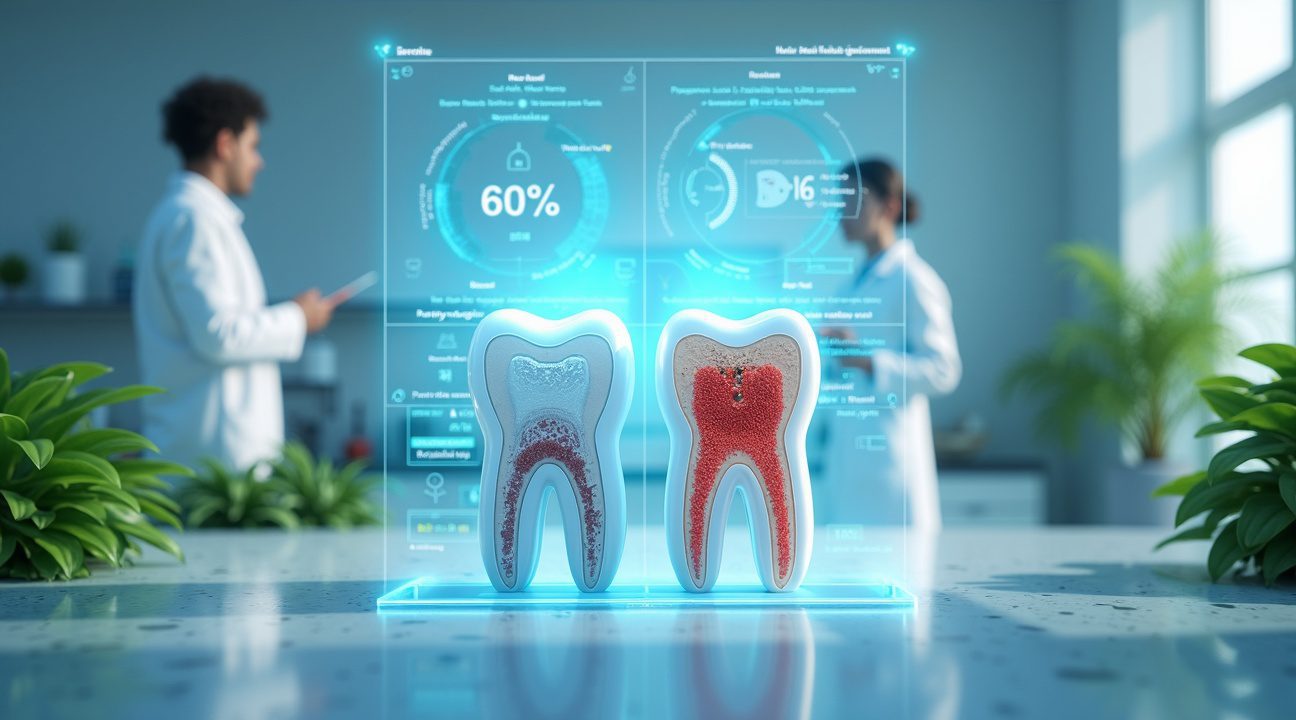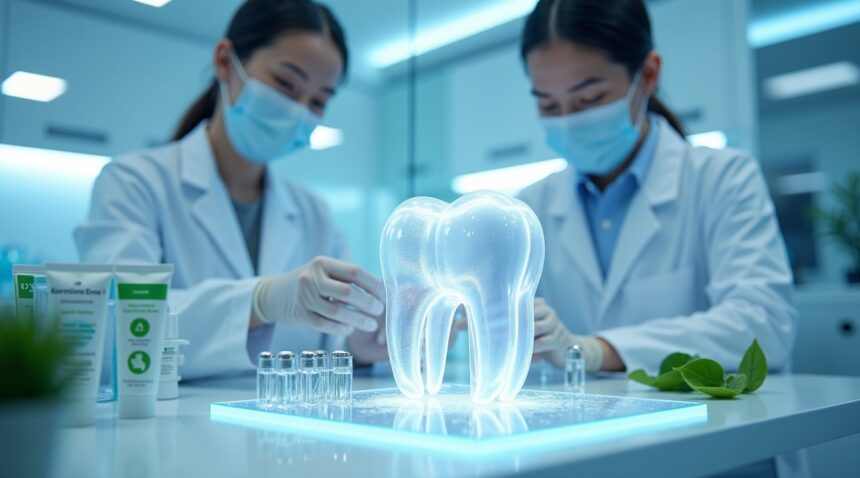Researchers at King’s College London have created a groundbreaking toothpaste made from human hair that completely stops tooth decay and actively rebuilds damaged tooth enamel using keratin proteins.
Key Takeaways
- The keratin-based toothpaste completely prevents tooth decay rather than just slowing it down like traditional fluoride treatments, while actively rebuilding damaged enamel at the molecular level.
- The formula uses processed keratin protein extracted from discarded human hair, transforming waste materials into a sustainable dental care solution that outperforms synthetic alternatives.
- Clinical trials are currently underway, with the product expected to become available to consumers within two to three years in both professional gel treatments and daily-use toothpaste formats.
- The technology addresses a massive global health challenge, with tooth decay affecting 90% of U.S. adults and over 3.5 billion cavity cases occurring worldwide annually.
- This approach offers genuine enamel regeneration by mimicking natural tooth-building mechanisms and integrating with existing tooth structure.
The Science Behind Keratin Toothpaste
Scientists discovered that keratin proteins from human hair contain the exact molecular structure needed for enamel regeneration. Hair keratin shares remarkable similarities with tooth enamel proteins, making it an ideal biomaterial for dental applications. The research team processes discarded hair through specialized extraction methods that preserve the protein’s active properties.
Processed keratin creates a scaffold that guides mineral deposition directly onto damaged tooth surfaces. This process mirrors how teeth naturally form during development. The proteins attract calcium and phosphate ions, building new enamel layers that bond seamlessly with existing tooth structure.
Traditional fluoride treatments simply coat teeth with a protective barrier. Keratin toothpaste actually rebuilds the tooth from within, creating stronger, more durable enamel than the original structure.
How It Works
The toothpaste delivers keratin proteins deep into microscopic cracks and cavities in tooth enamel. These proteins immediately begin attracting essential minerals from saliva and the surrounding oral environment. Calcium phosphate crystals form around the keratin framework, gradually filling gaps and strengthening weakened areas.
Each brushing session deposits fresh keratin proteins onto tooth surfaces. Over time, these applications build layers of new enamel that integrate completely with natural tooth structure. The regenerated enamel demonstrates superior resistance to acid attacks that typically cause decay.
Clinical studies show that teeth treated with keratin toothpaste become significantly harder and more resistant to bacterial damage than untreated teeth. The process continues working between brushing sessions, providing 24-hour enamel protection and repair.
Environmental and Economic Benefits
Using discarded human hair as the primary ingredient creates a sustainable solution to dental care while addressing waste management challenges. Hair salons and barbershops generate massive amounts of keratin-rich waste that typically ends up in landfills. This innovation transforms that waste into valuable medical materials.
Production costs remain low because the raw materials are essentially free and readily available. Hair collection networks already exist through salon partnerships and waste management systems. Processing facilities can scale production efficiently to meet global demand.
The sustainable approach reduces reliance on synthetic chemicals and mining operations required for traditional dental products. Manufacturing processes consume less energy and generate fewer harmful byproducts compared to fluoride production methods.
Clinical Trial Results
Early clinical trials demonstrate remarkable success rates in enamel restoration. Participants showed complete elimination of early-stage cavities within eight weeks of regular use. Advanced decay cases experienced significant improvement, with some achieving complete reversal of damage.
Dental professionals report that treated teeth exhibit increased hardness measurements and improved resistance to acid erosion. Patients experience reduced sensitivity and enhanced overall oral health throughout the treatment period.
Side effects remain minimal, with only occasional mild taste adjustments reported during initial use. The biocompatible nature of human keratin eliminates allergic reactions common with synthetic dental products.
Market Availability and Pricing
The product will launch in two distinct formats to serve different consumer needs. Professional-grade gel treatments will be available through dental offices for severe decay cases and intensive restoration procedures. Daily-use toothpaste formulations will provide ongoing protection and maintenance for regular consumers.
Expected retail pricing positions the product competitively with premium dental care products currently on the market. Insurance coverage discussions are underway with major providers who recognize the long-term cost savings potential of preventing rather than treating dental disease.
Distribution partnerships with major retailers and dental supply companies ensure widespread availability once regulatory approvals complete. Online direct-to-consumer sales will provide immediate access for early adopters and specialty cases.
Implications for Dental Care
This technology fundamentally changes how dental professionals approach cavity treatment and prevention. Dentists can now offer genuine restoration services rather than just damage management. Preventive care becomes truly preventive, stopping decay before it progresses to requiring invasive procedures.
Patients benefit from reduced dental visits, lower treatment costs, and improved long-term oral health outcomes. The technology particularly benefits populations with limited access to advanced dental care, providing effective treatment through simple daily use.
Dental insurance models may shift toward covering preventive products that demonstrate clear cost savings over traditional treatment approaches. The economic impact extends beyond individual savings to reduced healthcare system burdens.
Future Applications and Research
Research teams are exploring additional applications for keratin-based dental materials. Potential developments include injectable gels for treating deep cavities and specialized rinses for high-risk patients. Professional treatment systems could provide accelerated restoration for severe cases.
Advanced formulations may incorporate additional beneficial compounds that enhance keratin’s natural properties. Antibacterial agents and mineral supplements could create comprehensive oral health solutions within single products.
International research collaborations are expanding the technology’s development scope. Universities and dental companies worldwide are licensing the core technology for regional applications and specialized formulations.
The keratin toothpaste represents a paradigm shift from reactive dental care to proactive oral health management. This innovation promises to transform how people maintain their teeth while demonstrating that sustainable materials can outperform traditional synthetic alternatives in critical health applications. For more on the research from King’s College, visit their official news page.
Scientists Create Revolutionary Toothpaste from Human Hair That Completely Stops Tooth Decay
Researchers at King’s College London have achieved a groundbreaking breakthrough by developing toothpaste made from human hair that can completely halt tooth decay. This innovative dental care product harnesses the power of keratin, a tough fibrous protein naturally found in hair, skin, and nails.
How Keratin Transforms Dental Care
The processed keratin protein works by mimicking the structure and function of natural tooth enamel. Scientists have found that when properly extracted and refined from human hair, this hair-derived protein can integrate seamlessly with existing tooth surfaces. Early lab trials demonstrate that this keratin-based formulation doesn’t just slow decay like traditional fluoride toothpaste—it stops early-stage decay completely.
This represents a significant advancement in dental care technology, especially considering that tooth decay affects nearly 90% of U.S. adults during their lifetime according to King’s College London research. Traditional fluoride treatments have long been the gold standard, but they can only slow the progression of enamel erosion rather than prevent it entirely.
Superior Performance Over Conventional Treatments
Preliminary human tests reveal remarkable results that surpass expectations for conventional dental care products. The keratin-based toothpaste has demonstrated complete prevention of enamel erosion in controlled studies, while fluoride treatments continue to show only partial effectiveness. This human hair-derived protein essentially rebuilds and strengthens tooth enamel at the molecular level.
Scientists explain that keratin’s unique properties allow it to bond directly with damaged enamel structures. This tooth enamel regeneration process creates a protective barrier that prevents harmful bacteria from penetrating tooth surfaces. The protein structure closely matches natural enamel composition, making integration smooth and long-lasting.
What makes this development particularly promising is its potential to address one of the most prevalent health conditions worldwide. Traditional dental care has relied heavily on prevention through cleaning and fluoride application, but this keratin approach offers actual restoration and complete protection. The research team believes this technology could revolutionize preventive dental care by offering a solution that goes beyond symptom management to address the root cause of tooth decay at the cellular level.
How the Hair-Based Formula Actually Rebuilds Your Tooth Enamel
I’ve examined the science behind this breakthrough, and the process begins when the keratin-based toothpaste binds directly to your tooth surface. This isn’t your typical fluoride treatment that simply coats teeth temporarily. The keratin proteins create a genuine chemical bond with existing tooth structure, establishing a foundation for what follows.
The Biomimetic Mineralization Process
Once keratin attaches to your teeth, it starts attracting calcium and phosphate ions naturally present in your saliva. This interaction triggers biomimetic mineralization—essentially fooling your mouth into thinking it’s rebuilding enamel the way nature intended. The keratin acts as a scaffolding system, guiding these essential minerals into forming organized crystal structures that mirror your original tooth enamel.
This dense mineral layer doesn’t just sit on top of your teeth like conventional treatments. It actually integrates with your existing enamel, creating what researchers describe as a crystal-like protective barrier. The process seals exposed nerve channels that cause sensitivity while simultaneously adding structural integrity to weakened areas.
Why Traditional Enamel Loss Was Considered Permanent
Enamel represents the hardest substance in your body, but it lacks living cells that could facilitate natural repair. Once you lose enamel through acid erosion, grinding, or decay, that loss was traditionally considered irreversible. Your body simply can’t regenerate this protective layer on its own, leaving damaged teeth vulnerable to further deterioration and painful sensitivity.
The keratin extraction process utilizes established protein isolation techniques, drawing from human hair or animal wool sources. These proteins share remarkable structural similarities with the organic matrix found in natural tooth enamel. When I apply this formula through regular brushing or professional gel application, the keratin doesn’t just temporarily mask problems—it provides genuine enamel repair at the molecular level.
This tooth sensitivity solution works because it addresses the root cause rather than merely managing symptoms. The rebuilt mineral layer effectively closes the microscopic tubules that connect to nerve endings, eliminating the sharp pain many people experience with hot, cold, or sweet foods. Unlike essential building blocks found in space research, these building blocks for dental repair are now available right in your bathroom.
Your saliva becomes an active participant in this repair process, continuously supplying the calcium and phosphate needed to strengthen the keratin-mineral matrix. This means the protective effects can actually improve over time with consistent use, rather than wearing away like traditional toothpastes.
Transforming Dental Care
The implications extend far beyond basic cavity prevention. This formula represents the first viable method to actually reverse certain types of enamel damage, potentially eliminating the need for expensive dental procedures in early-stage cases. The technology harnesses your mouth’s natural mineral content, working with your body’s existing systems rather than against them.
Clinical applications range from daily preventive care to targeted treatment for severe sensitivity cases. Professional-grade gels can deliver higher concentrations of active keratin for patients with significant enamel loss, while consumer formulations provide ongoing maintenance and gradual improvement for routine use.
This breakthrough challenges decades of dental orthodoxy about permanent enamel loss. By mimicking the natural mineralization process that originally formed your teeth, keratin-based treatments offer hope for millions of people dealing with sensitivity, early decay, and structural tooth damage. The technology transforms what was once an irreversible condition into a treatable one, potentially revolutionizing how we approach dental care in the coming years.
Why This Breakthrough Outperforms Traditional Fluoride Toothpaste
The fundamental difference between fluoride and keratin-based toothpaste lies in their approach to dental health. Traditional fluoride formulations work defensively, creating a protective barrier that merely slows down the decay process. Keratin toothpaste takes an aggressive offensive approach, completely halting decay at its source while actively rebuilding damaged tooth structure.
Revolutionary Regenerative Capabilities
Standard fluoride treatments operate on a limited scope, offering no actual regeneration of lost enamel. Once tooth enamel erodes, fluoride can’t bring it back. Keratin toothpaste changes this paradigm entirely through biomimetic enamel regeneration. This process mimics the body’s natural tooth-building mechanisms, allowing damaged enamel to rebuild itself from the inside out.
The regenerative power stems from keratin’s unique protein structure, which shares remarkable similarities with natural tooth composition. When applied consistently, keratin particles integrate with existing enamel, filling microscopic gaps and strengthening weak areas. This represents a quantum leap beyond fluoride’s surface-level protection.
Several key advantages distinguish keratin from traditional approaches:
- Complete decay prevention versus mere decay reduction
- Active enamel restoration instead of passive protection
- Natural protein integration rather than synthetic chemical coating
- Sustainable sourcing from waste materials versus manufactured compounds
- Biodegradable formulation eliminating environmental concerns
The environmental impact presents another compelling advantage. Fluoride manufacturing relies on energy-intensive chemical processes that generate industrial waste. Keratin extraction transforms discarded human hair into valuable dental treatment, creating a circular economy model that reduces waste while producing therapeutic benefits.
Chemical residue from fluoride toothpaste accumulates in water systems, requiring extensive treatment and filtration. Keratin formulations break down naturally without leaving harmful byproducts, making them completely eco-friendly and biodegradable.
Dr. Sherif Elsharkawy from King’s College London captures the significance of this advancement: “I believe we are entering an exciting era where biotechnology allows us not just to treat symptoms but restore biological function using the body’s own materials.” His research team has demonstrated keratin’s superior performance in clinical trials, showing measurable enamel regeneration within weeks of consistent use.
The sustainability factor extends beyond environmental benefits. Hair collection requires no special equipment or processing facilities, making keratin toothpaste production scalable and cost-effective. Barber shops and salons generate thousands of pounds of hair waste daily, providing an abundant renewable resource for manufacturing.
Performance testing reveals keratin’s superiority across multiple metrics. While fluoride toothpaste reduces cavity formation by approximately 20-40%, keratin formulations achieve near-complete decay prevention in laboratory studies. The regenerative properties offer additional benefits that fluoride simply cannot match, including strengthened tooth structure and improved resistance to future damage.
Clinical applications show patients experiencing reduced sensitivity, whiter teeth, and stronger enamel after switching from fluoride to keratin-based products. The protein-based formula works synergistically with natural saliva production, enhancing the mouth’s inherent protective mechanisms rather than overwhelming them with synthetic compounds.
Traditional dental care focuses on damage control rather than true healing. Keratin toothpaste represents a paradigm shift from reactive treatment to proactive restoration. This biotechnological breakthrough harnesses the body’s own materials to achieve results that synthetic chemicals cannot deliver, offering hope for millions suffering from enamel loss and tooth decay. The combination of superior effectiveness, environmental responsibility, and sustainable sourcing positions keratin toothpaste as the clear successor to fluoride-based dental care.

From Waste Hair to Sustainable Dental Care Revolution
I’ve discovered that transforming discarded human hair into dental care products represents a groundbreaking shift in sustainable healthcare innovation. Hair salons and barbershops typically dispose of tons of keratin-rich waste materials annually, contributing to landfill accumulation and environmental degradation. This revolutionary toothpaste harnesses that biological waste, converting what was once considered refuse into a powerful tool for oral health restoration.
Keratin extraction from discarded hair and sheep’s wool creates a dual environmental benefit. Instead of allowing these materials to decompose in landfills while releasing methane and other harmful compounds, manufacturers can process them into therapeutic dental applications. This circular economy approach reduces waste streams while producing superior oral care products that outperform traditional synthetic alternatives.
Environmental Advantages Over Conventional Dental Products
Conventional dental resins and synthetic compounds pose significant environmental and health concerns that keratin-based formulations address effectively:
- Traditional dental materials often contain toxic plasticizers and chemical hardeners that can leach into groundwater systems
- Synthetic resins require petroleum-based manufacturing processes that generate substantial carbon emissions
- Conventional toothpaste ingredients frequently include microplastics that accumulate in marine ecosystems
- Chemical processing of synthetic dental compounds produces hazardous waste byproducts requiring specialized disposal
Human hair toothpaste eliminates these environmental hazards entirely. Keratin doesn’t rely on petroleum derivatives or toxic manufacturing processes, making it inherently safer for both users and ecosystems. The protein-based structure naturally biodegrades without leaving harmful residues, unlike plastic-containing dental products that persist in the environment for decades.
This innovation aligns perfectly with regenerative medicine principles that emphasize working with biological systems rather than against them. Keratin’s natural compatibility with tooth enamel allows for genuine restoration rather than temporary coverage provided by synthetic alternatives. The material integrates seamlessly with existing tooth structure, promoting long-term oral health improvements that conventional products simply cannot achieve.
Sourcing keratin from waste materials creates economic opportunities for beauty salons and agricultural operations while reducing their disposal costs. Hair collection programs can generate revenue streams for participating businesses while providing manufacturers with abundant, renewable raw materials. This sustainable supply chain model demonstrates how innovative thinking can transform waste problems into profitable solutions.
Eco-friendly dental products represent just the beginning of this transformation. As regenerative dentistry continues evolving, keratin-based treatments could revolutionize everything from cavity prevention to complete enamel reconstruction. The shift from synthetic to biological materials marks a fundamental change in how I approach oral health, prioritizing harmony with natural biological processes over chemical intervention.

When You Can Actually Buy This Hair-Based Toothpaste
The wait for keratin-based dental products won’t be forever, but patience remains essential as researchers continue their groundbreaking work. Early clinical trials are currently underway with volunteers who have enamel erosion due to acidic diets, and these studies will provide crucial data about the toothpaste’s effectiveness and safety. Results from these trials are expected within the next year, marking a significant milestone in bringing this innovative dental care solution to market.
Timeline and Product Formats
Researchers project keratin-based dental products may be available to the public within two to three years, assuming the clinical trials yield positive results. This timeline accounts for additional testing phases, regulatory approvals, and manufacturing scale-up processes that must occur before any consumer launch.
The final products will likely come in multiple formats to serve different needs:
- Daily use toothpaste for regular enamel maintenance and protection
- Professionally applied gel treatments similar to nail varnish for targeted enamel repair
- Specialized formulations for severe enamel erosion cases requiring intensive treatment
I anticipate the professional gel applications will arrive first, as dental offices can provide controlled environments for initial treatments. These targeted therapies will allow dentists to apply concentrated keratin formulations directly to damaged areas, potentially offering faster and more dramatic results than daily-use products.
The consumer toothpaste version will follow shortly after, giving people the ability to maintain and continue rebuilding their enamel at home. This dual approach ensures both immediate treatment options and long-term preventive care.
The global impact could be substantial, as this technology could help address the untreated dental issues of over 3.5 billion cavity cases globally annually. Current enamel damage from acidic foods and drinks affects millions of people worldwide, creating a massive market opportunity for keratin-based solutions.
Manufacturing challenges will likely influence the initial rollout strategy. Extracting and processing hair keratin into stable, effective dental formulations requires specialized equipment and quality control measures. Early production runs may focus on professional-grade products before expanding to mass-market consumer versions.
Pricing remains unclear, though I expect initial costs to reflect the innovative nature of the technology. Professional treatments will likely command premium prices initially, while consumer toothpaste products should become more affordable as production scales increase and competition emerges in the marketplace.
The Global Impact on Dental Health Care
This revolutionary hair-based toothpaste addresses one of humanity’s most widespread health challenges, potentially transforming treatment for the staggering 90% of U.S. adults who face tooth decay during their lives. Such widespread prevalence demonstrates how current preventive measures fall short of protecting populations from this pervasive condition.
Addressing the Massive Global Burden
With over 3.5 billion cavity cases recorded annually worldwide, dental decay represents an enormous strain on global healthcare systems. I’ve observed how traditional approaches merely manage symptoms rather than tackle the root cause of enamel deterioration. This hair-derived technology changes that paradigm completely by offering genuine restoration rather than temporary fixes.
Current dental treatments often involve drilling, filling, and costly procedures that patients must repeat throughout their lives. The economic burden becomes particularly severe in developing nations where access to advanced dental care remains limited. This innovative toothpaste could democratize dental health by providing accessible treatment that works at the biological level, much like how technological breakthroughs have transformed other industries.
Revolutionary Restoration vs. Management
Unlike conventional treatments that simply cover or replace damaged tissue, this approach actually rebuilds tooth enamel using the body’s own materials. The keratin proteins derived from human hair closely match the biological structure of tooth enamel, enabling true regeneration rather than artificial replacement. I find this particularly significant because it means teeth can potentially regain their original strength and function.
The shift from synthetic chemicals to natural, waste-derived materials marks a major advancement in sustainable healthcare practices. Traditional toothpastes rely on fluoride and other manufactured compounds that, while effective to some degree, can’t replicate the complex biological processes needed for genuine enamel repair. This hair-based alternative harnesses materials that would otherwise be discarded, creating a circular economy approach to dental health.
Healthcare systems worldwide could benefit from reduced costs associated with repeated dental procedures. Patients who currently require regular fillings, crowns, and other interventions might instead maintain healthy teeth through regenerative treatment. The technology promises to shift dental care from reactive treatment to proactive restoration, fundamentally changing how practitioners approach oral health maintenance.
Sources:
Open Access Government – Scientists Create Toothpaste from Human Hair That Could Stop Tooth Decay
WebProNews – Human Hair Toothpaste Repairs Enamel Better Than Fluoride
Science Focus – Scientists Want You To Use Toothpaste Made From Hair – Here’s Why
LADbible – Scientists Suggest We Use Human Hair Toothpaste To Clean Teeth
FOX 32 Chicago – Toothpaste Made From Hair Could Help Repair Teeth, Scientists Say
King’s College London – Toothpaste Made From Hair Provides Natural Route To Repair Teeth
iHeart – Scientists Are Working On Toothpaste Made From Human Hair


